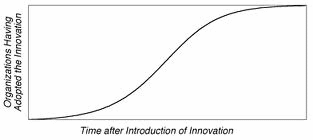
Bass Curve

 |
Bass Curve |
 |
|
Articles | Books | Dictionary | Faq | Home | Leaders | Organizations | Search
|
Bass Diffusion |
Summary of the Bass Curve. Abstract |
Frank M. Bass (1969) |
The Bass Curve on the adoption and diffusion of new
products and technologies by Frank M. Bass (A New Product Growth
Model for Consumer Durables, 1969, Management Science, 15 , 215-227) and
the later extensions of diffusion theory are used for market
analysis and demand forecasting of new technologies. The Bass
diffusion model is one of the tools to describe, and sometimes predict,
the number of purchases for new consumer durable products.
Experience from many innovations shows that the spread of a new method or concept in a market can be characterized by the Bass formula:

The three parameters of the
BDiff
Model to predict Nt (Number of adopters at
time t) are:

m = the market potential; the total number of people who will eventually use the product
p= the coefficient of innovation (external influence); the likelihood that somebody who is not yet using the product will start using it because of mass media coverage or other external factors
q= the coefficient of imitation (internal influence); the likelihood that somebody who is not yet using the product will start using it because of "word-of-mouth" or other influence from those already using the product.
See the picture on the right for a typical graphic of the standard bass curve (with the average values of p and q of 0.03 and 0.38, respectively).
Bass diffusion theory is simple enough to allow a first assessment without the need for further complex modeling. However care must be taken as the standard model is only one of the many models of technology diffusion. Many variations on the BDiff model have been developed over time, often claiming further precision or applicability for certain circumstances.
The dynamics of the innovation uptake curves and how the
technology or its application diffuse into the market is a crucial
analytic tool when assessing the business case for internal or external
investments in new technologies. For early stage investments or internal
business cases for new products, it is essential to have some
understanding of the likely diffusion of the technology. By not having a
mental model to test against reality, the amount of capital, time to
market and the window of opportunity can be grossly misjudged. Diffusion
of innovation models are important tools for
effectively assessing the merits of investing in technologies that are
new or novel and do not have prima facie, predictable patterns of user
up-take.
| 👀 | TIP: To learn more, have a look at the Bass Diffusion center: Summary, forum, tips and tools. |
Compare with the bass diffusion model: Innovation Adoption Curve (Rogers) | Product Life Cycle | BCG Matrix | ADL Matrix | Positioning | STRATPORT | Profit Pools | Marketing Mix | Four Trajectories of Industry Change
About us | Advertise | Privacy | Support us | Terms of Service
©2025 Value Based Management.net - All names tm by their owners